
On the right the drawing of TDL Monitor Studio 4, similar to TDL Monitor Compact, with more robust enclosure compared to 4 way TDL Monitor
IMF and TDL are linked under the same idea of speaker, the Transmission Line, around this idea in UK work some of best speaker designer as Irving M. Fried, John Stuart Wright, Jim Thiel, Andy Lockwood. After the work of those expert what do you aspect on sound quality and accuracy?
The old address is "TDL transducer, Transducer Development Ltd, High Wycombe, Bucks, tel (0494) 35576". Today exist a web site in UK but seems to be frizzed.
Can I rewrite all of TDL and IMF history here? Probably is best present links available at august 2014, see below:
BE CAREFULL, the drawing and ALL photos are under copyright and you have NOT right to use without written authorisation from me. The drawing came from a work of my fried architects using an old draw from a TDL leaflet.
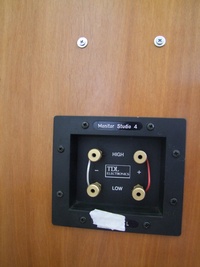
The history of speaker production, first in USA with the name I.M.F., after in U.K,, more with coworking with Elac, someone speaking of a litigation and born of TDL brand (with some speakers build in Germany), more production in USA with poor speaker, and so on.
Fortunately this one have the original binding post, see photo, and serial number with L and R mark.
Above the binding post and socket of this TDL we can see the four inox pass through screws fixing the mid-high-pass part of crossover in place of the poor wood screws from inside (the large photo is here)
The original xover is large and "high" and put in the inner port of the transmission line tube, not a good position, see the drawing above.
So the original PCB board of crossover (marked TDL Electronics) was cut in two parts, one with bass-pass put in the original position, and the mid-high-pass put over the binding post, practically under the internal box for midrange speaker.
A similar model was produced by Germany distributor of TDL, see those 3 pages of the leaflet of A.O.S. Ascot speaker, page1, page2, page3.

As show in the drawing the midrange have a small box build as a pyramid on the top of the speaker filled with 2 different wool.
The fixing of speakers is one other mystery. See a zoom of the photo the midrange, and all other components, was fixed with Captive T nuts but with M4 screw not whitworth, also the head of the screw use the Brugola metric to fix it.
In photo we can see also the internal cable, a QED crystal type, 1.5mm2 section.
An accurate lecture of the photo show the quality of the wood used. Really is not a wood but a high density MDF and the very thin placage de bois as ready to detach glue or not.
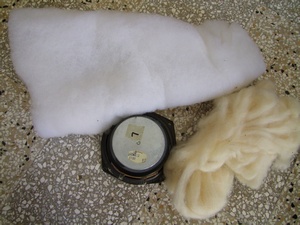
The midrange has a separate box. Measure the volume of this is about 9 litres and it is filled with 2 different wools.
See on the left, the white material stay on the cuneiform section of the box, the yellow part stay behind the speaker. The large photo is here
Jerry Bloomfield in 2011 produced a list af Elac speaker used by IMF and TDL, we can find here here, but I suppose there is almost one error, for this midrange as example. Jerry list this values:
Model: 130NS 13, Size mm: 131, Depth mm: 70, Coil mm: 25, Surround: rubber, Cone: polypropylene, Frequency: 250-4000, Cont. power W: 40, Amp. power W: 150, Resistance ohm: 7.40, Impendence ohm: 8, Mechanical Qm: 1.80, Electrical Qe: 0.48, Total Qt: 0.38, Equivalent volume Vas: 11.6, Resonant Fs at Hz: 52, Sensitivity dB: 84.5. The large photo of my is here

What's is the differences in impedance and phase in a speaker running with and without the surround? The rubber of 130NS 13 is dead, all the surface have cracks and in some points there are detach with frame, see photo. The large photo is here
The new surround is similar in dimension to "EC-113A" but the rubber must be for midrange, not for mid-woofer. In Italy you must go to Trecastelli, near Ancona, to visit one of the best producer of foam, rubber, fabric for speakers (and spider, and dust cover, and ..), the OEB. But you can do a phone call if you live outside of Italy.
By restoring the first, I have a complete one and a disassembled midrange, from which an idea is born. How do the parameters of a speaker change according to the surrounding? For a first answer it would take; a midrange and 3 different suspensions, in foam, rubber, and fabric.
But we can start with this midrange, put the dust cover back on the one without suspension and do some measurements. Having a speaker without suspension you will need to make them work all 2 face up, with the magnet resting on a plane, indeed on several layers of thick rubber, and measuring only the electrical parameters in the air.

On the left the kit LX-1746 of defunct company Nuova Elettronica, kit LX-1746. This is an interesting complex measure instrument, with inside one audio card, one small amplifier and some calibrate resistors. All the work is done bye the software, from PhD. Alfredo Accattatis, today at Rome3 University. You can find description of Visual Analyser Project, and software at Sillanumsoft.org.
For calibration you must find some R, L, C with certified values "near" the values to be measured, almost 1% or better 0.5% of tolerance. Mouser, RS, TME, Distrelect have, but expensive.
Unfortunately the only really working version of the software, for me, is the 2011xe version. I test in 5 different computers from Win Xp to Win 8.1, from notebook to expensive desktop, but all the new version have problems and problems.
To compare the 2 speakers we can use the function to measure the impedance at various frequencies called "sweep function". This function produces an abnormal occupation of RAM so the spectrum must be divided into several parts, not too bad since using a 10Hz step to measure at 17410Hz, 17420Hz, 17430Hz doesn't make much sense.
When I started using this software I loved it, now I always discover new design-errors that are not solved, the Help is quite inexistent, no one manual (nor from users) is available, but only new and new UNDOCUMENTED functions are added. As example see this one.
 |
| the ZRLC windows of the Visual Analyser running sweep calibration, the manual setting is Z=impedance, see the yellow circles, upper the frequency, on the left the R value, in the middle the Z value, and down the Phase degree, please remember. |
Hit Capture auto in the window above the procedure of sweep, step by step, calibration start. When terminate we must connect the speaker and start the measure, see on the figure show the values at point 17 as 170Hz starting from 10Hz and with step of 10Hz.
When the sweep terminate we must hit the View captured button and obtain the following.
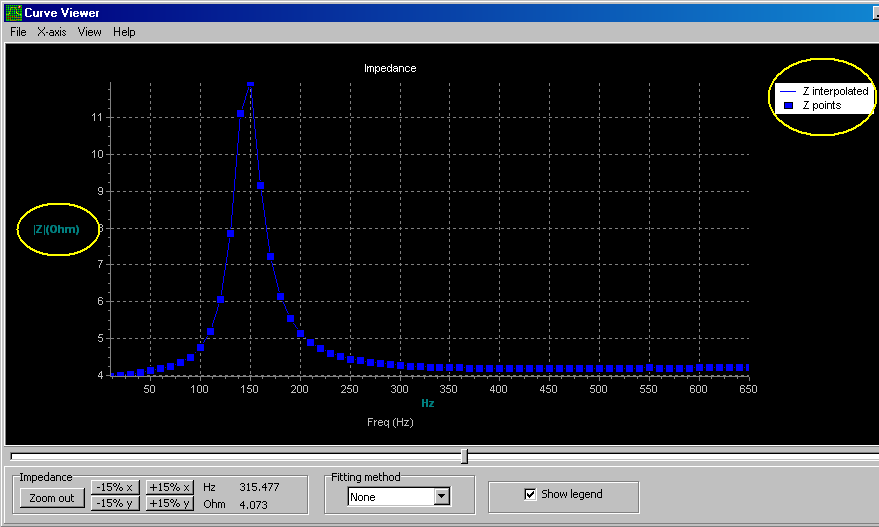 |
| This graph appears after hit the View captured button. Where are the other values? In the figure above we can see the resistance real value, the impedance value and the phase degree, necessary to describe a non-linear electrical device, as; Choke, Speaker, Snubber, Coil, and so on. |
As show in the first figure the software measure all of this necessary, essential, parameter (measure also Imaginary R value) and probably storage in the abnormal use of RAM, but do NOT SHOW. Without the software is a piece of junk, or a game for children, unfortunately.

130NS 13 with and without surround
With an incredible hard and complex work outside the capacity of almost all users we could obtain a table with the required measures. For ringworm I decided to try the operation instead of using another software that does it in minutes not days.
How you do it?
But do you realize that it takes a whole day of work and a lot of different software?
VA2011 is not bad there are many functions but only one author has limits and after a while his creature gets out of hand, that's why the best open-source software is managed by a community, maybe only 5 users but each specializing in a task (program complexity grows until it exceeds the capability of the programmer who must maintain it; the 7th Murphy's computers law).
However after 2 days a good result is obtained, see below.
 |
| The midrange 130NS 13 with new rubber, open air, face up, insulate from the table with rubber felt, after 2 days of work the curve obtained from VA2011 with NE LX.1746 kit. |
Thanks Mr. Irving M. Fried for choosing, this is a true midrange not a mid-sub sold yesterday and today as a wonderful speaker but that struggles to reproduce all the voice and instruments in this frequency range that makes the "timbre" of the speaker. Please compare this chart with your midrange chart!
I remember a similar design, a real Audax midrange, looking through the saved files I found the scan of a vintage catalogue, my file only says Audax-13cm, but it doesn't give the model.
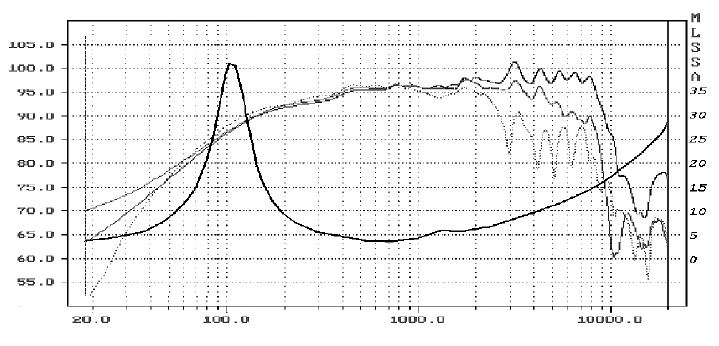 |
| An old, vintage Audax midrange, 8 ohm, 130 mm, 5 inches (obtained with old expensive, difficult to use, never update MLSSA hardware-software) |
We note the same dip at about 1200 Hz, about the same Z value at the resonance and also the same resonance frequency. But let's go back to the supposed difference between with and without surround.
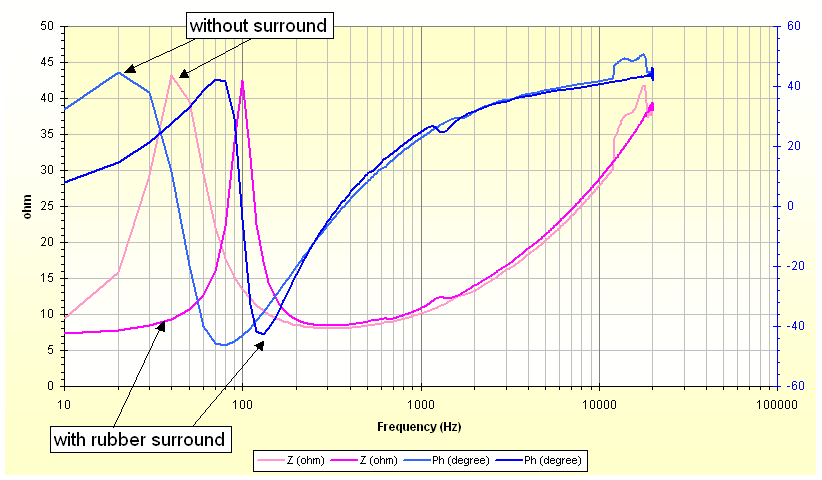 |
| 2 midrange 130NS 13 with and without rubber surround; all in open air, face up, insulate from the table with rubber felt Are evident some difference. |
Without surround the curve are "larger" the values are quite higher, the break-up of the cone is evident over 10KHz, but the dip at about 1200Hz disappear.
Soon if I find a real midrange (you need a mid since the Fr lowers a lot without suspension), to which you can mount 3 different surrounds I will repeat the measurement, but perhaps with another software like ..... good search.
If the 2 midrange are really dead I suggest replace they with JBL-2480 + JBL-2328 + JBL-2350, probably without xover modification.

Having time I can spend other 2 full days to measure the 2 Woofers and the 2 Tweeters and design a chart similar to the above.
I find a spare time to measure the tweeter 25DT 31. On the left the photo of the tweeters. The large photo is here.
Reading from a previous cited list of Jerry Bloomfield we can show, Model: 25DT 31, Size mm: 120 X 90, Depth mm: 45, Coil mm: 25.4, Cone: aluminium, Cont. power W: 40, Amp. power W: 150, Resistance ohm: 6.8, Impendence ohm: 8, Resonant Fs at Hz: 750, Sensitivity dB: 87. The tweeter label is here.
We can see in photo a cover of tweeter, similar to a Mesh Tea Strainer, someone can think to preserve the speaker. I suppose this is a form of mechanical dumping in high frequency as often we can see with a piece of fabric under the dome.
I suppose this is a cut and reused tea strainer (after select the correct mesh), but it's probably a specially made piece of hardware.
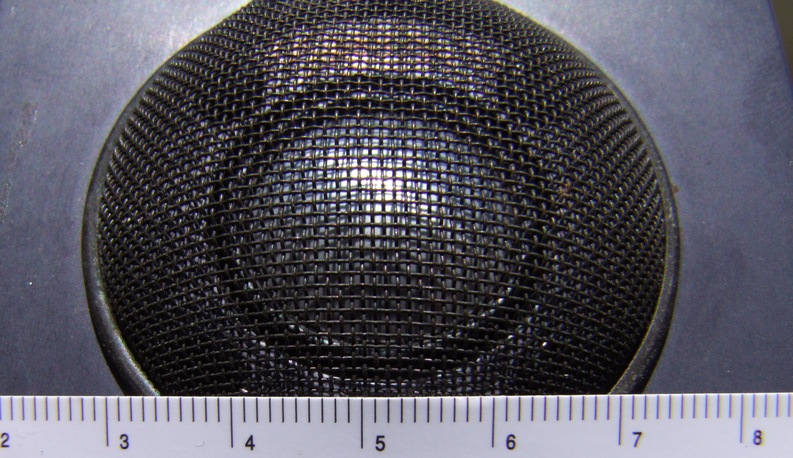 |
| A net covers the dome, why? To protect it from shocks, or to filter the emitted frequencies, or for some kind of damping. It was originally fixed with 4 glue points, but the magnetic field also holds it in place (it is supposed to be of soft iron then). |
The Internet has given voice to millions of idiots and incompetents who pontificate and discuss about things absolutely unknown to them. Their only habit is to show their ignorance and defend empty words spoken by them whose meaning they don't even know.
Why this outburst? In Italy there will be only 2 people, maybe 3, from whom I would accept advice on how to replace a woofer or tweeter. Let's name suggestion from Fabrizio Calabrese, from Sergio Canini, from the passed away Renato Giussani are accepted, from the other 1000 who write on the Internet I trust less than a bank note of 1 dollar of blue colour.
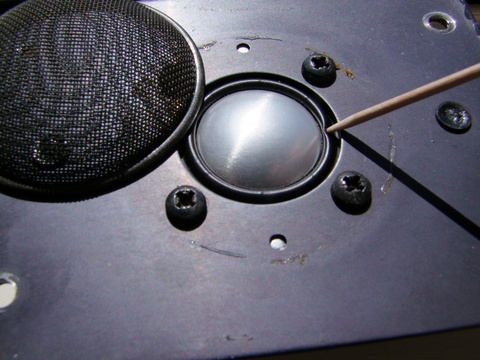 |
| The large photo is here. Replace this tweeter is not easy, see the rubber surround and the aluminium dome. |
If you replace the 25DT-31, see the rubber suspension, the dome, the rear small box covering the vented hole, you will certainly have some sound but not the one thought by Mr. Fried.
Can the mesh filter the high frequency? First we must measure the dimension of single mesh, see the photo with the tea-strainer fitted in place
 |
| Some measure, with aid of ImageJ, on the macrophoto of the tweeter's net. The hole have a square form with a wire diameter from 0.24 to 0.28mm and open light from 0.6 to 0.56 mm. |
The speed of sound is 331.3 m/s (STP), so with a simple calculation we can find the wavelength "similar" to the distance of the wire as lambda=394 KHz or similar to the open hole lambda=500 KHz. To obtain the diffraction at 10 KHz the wire distance must be 3.3 mm.
After another 2 days of work with VA2011 we can compare the impedance of the tweeter with and without the mesh dome, measured face up.
 |
| The same tweeter is measured with and without the beautiful black dome shown above. As speculated, the genius Mr. I.M. Fried uses part of a net tea strainer to reduce impedance. Note that the Y scale is only 4 ohms wide. The two resonances near 1KHz suggest a high pass filter above 2KHz. Mouse over to see L tweeter. |
The left tweeter is more interesting, the naked tweeter has a break-up near 18KHz (probably a draft from the rear cover chamber) but with the mesh cup mounted disappears.
As we can see, the tweeters are quite different, but very similar (30 years old, but I would like to measure 2 new ones, sealed to control modern production). In any case, the effect of the mesh dome starts from almost 4900 Hz, "coincidentally" at a wavelength equal to the diameter of the dome.
The crossover frequency for 4-way TDL Monitors are 300, 3500, 13000Hz, according to the producer, and for Studio 4 and Monitor Studio they are 300, 3500Hz, exactly at the point of rising of the impedance Z.
If the 2 tweeters are really dead I suggest replace they with Mundorf AMT27D1.1, probably without xover modification :-) (so I contribute to stupid suggestions present in Internet).

Finally an analysis of the Woofer, wait please.
I buy this speaker about 4 years ago and promise me to restore/upgrade early! But find time to dismount completely, find all necessary new components and rebuild is not so easy. Finally, in 2014, I find time to mount all previous obtained components as Mundorf M-Cap, Vishay resistor, Stannol Sn-Pb-Ag, inox screws, soft Pyramid Studio Foam and so on.
Next week I wrote other part of this page, but I can anticipate the crossover of this TDL Studio 4.
Donations if you have a Bitcoin wallet
If you have a nice fat wallet you can send a few cents to this code 1ETv1mJTZTB7EiXwZkucF2BTA512Rkaw6 maybe with a message (be careful to the transaction cost, send 0.1 and pay 0.01 is not a good idea).
1ETv1mJTZTB7EiXwZkucF2BTA512Rkaw6 <== my code , Thank you.
Donations if you have not a Bitcoin wallet
If you like this work and measures you can make a small donation of Bitcoin. You do not need a wallet to make a donation, indeed even those who have Bitcoin wallet is better to pass for a web site that "gift" currency since this does not have a transaction cost.
To make a donation you must use some of your web-time on a Bitcoin Faucet, please go to Kickasstraffic.com, enter my code 1ETv1mJTZTB7EiXwZkucF2BTA512Rkaw6 into empty cell and press "Start Earning", a new sub-page appear, do not touch other then the last 2 buttons in lower right corner "Surf Ads" and "Active Window Ads".
If appear a tweet asking to register use the lower right corner button "Close", solve the Captcha and proceed. Of course any next page if different but I suggest you to stay more time possible reading pages and advertisement to produce Bitcoin (1/100000 I suppose) for me.
Be careful, do not use roulette, dices, casino and other stealing web site, as claim of supposed infection. We use Kaspersky Free Antivirus by 2 years without problems.
1ETv1mJTZTB7EiXwZkucF2BTA512Rkaw6 <== my code , Thank you.
| In the last years at Universita' Degli Studi di Roma La Sapienza |
Dr. G. Visco already contract professor for Chemistry in Environment & Cultural Heritage into --> |
Corso di Laurea in: Scienze Applicate ai Beni Culturali ed alla Diagnostica per la loro Conservazione |